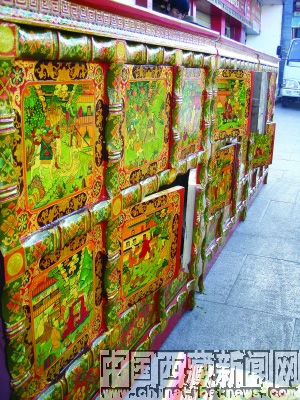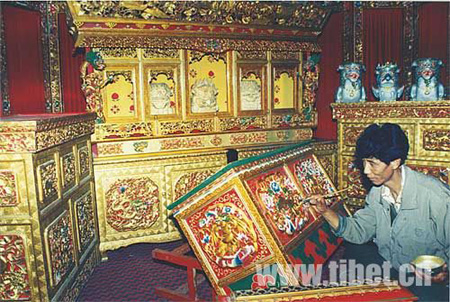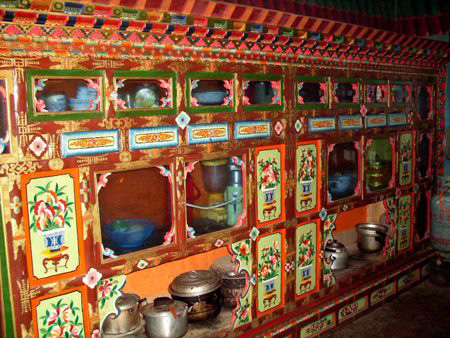
Tibetan-style furniture falls into three major categories: chests, cabinets, and tables.
Tibetans are accustomed to sitting on the ground, so benches or chairs are rarely seen in their homes.
Tibetan cabinets are used to store butter and cheese; that is why they always feel greasy. Anyhow, a layer formed by butter lamps' oil stain and its soot is considered to be able to effectively protect the cabinets' inside surface. So, if you have such Tibetan cabinets covered with this "precious coat," do not try to wash or polish it off.
Tibetan tables are always painted in colors or engraved with such patterns as dragons, weird animals, leaves or bamboos. They are widely used in Tibetans' daily life and religious ceremonies. Some tables are made folding so as to be easily carried when Tibetans spend their Lingka Woods Festival (During the festival, Tibetans dressed in traditional costumes will set up tents in an open ground and enjoy the nature while singing, dancing and having delicacies.)

Tibetan chests, dating back to the 17th or 18th century, feature unique painting arts. These chests are painted either directly on surface, or on a piece of flax covering the surface.
Painting crafts of modern Tibetan furniture are an attribute of the all-embracing Tibetan arts, reflecting the unity between the Han and Tibetan ethnic groups, according to the boss of a Tibetan furniture store on the Beijing Road (E) in downtown Lhasa.
It was recorded in historical books like "the Legend of King Gesar" that influenced by cultures from ancient India, Kashmir and China's central plains, classic art schools in Tibet had absorbed art characteristics of these cultures and applied them to their own works.

Photo shows a Tibetan cabinet placed with household appliances in an ordinary Tibetan home. (Photo Source: chinatibetnews.com)
Over the past decades, diligent Tibetan people have created such an outstanding Tibetan ethnic furniture culture by combining their drawing art with carving skills and decorative techniques.
Forests are mainly located in southeastern Tibet and humid areas in the southern section of the Himalayas. In old Tibet, due to poor transportation, fine furniture was owned exclusively by senior lamas and nobles. Ordinary Tibetan families only had few pieces of simple and crude house furnishing. Owning a set of exquisite Tibetan table, cabinet and chest was regarded as a great honor to the host.
